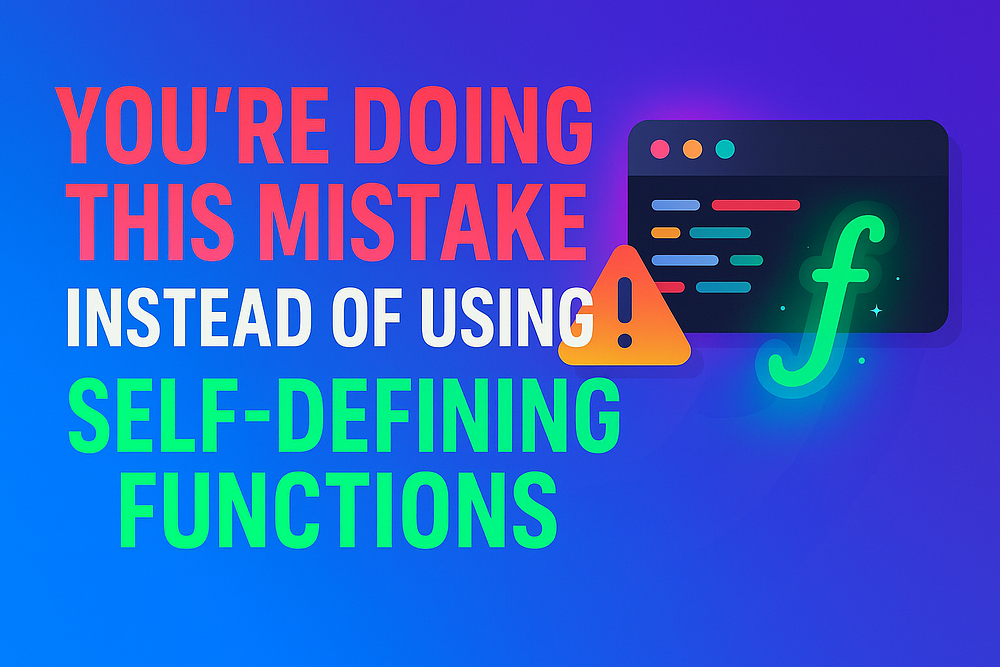Stop writing messy initialization code in JavaScript. Here’s how self-defining functions make your code cleaner, faster, and easier to maintain.

Introduction
We’ve all written code like this before:
- A function that does heavy initialization work the first time it runs.
- But on the second call, it still redoes all that work unnecessarily.
- So we clutter our code with extra conditionals and “firstRun” flags.
Example mistake:
let config;
function loadConfig() {
if (!config) {
console.log("Fetching config...");
config = { apiKey: "123", theme: "dark" };
}
return config;
}
console.log(loadConfig()); // Fetching config...
console.log(loadConfig()); // Still checks condition every time
This works, but it’s noisy and less efficient.
👉 The self-defining function pattern solves this elegantly: the function rewrites itself after the first call.
The Mistake Most Devs Make
Instead of leveraging self-defining functions, devs often use:
- Boolean flags (
let firstRun = true;) - Global state (
if (!window.cachedResult) {...}) - Unnecessary wrappers that make code harder to read
These patterns clutter logic, create hidden dependencies, and add runtime checks on every call, even after the first run.
Enter: Self-Defining Functions
A self-defining function (also called self-rewriting) changes its own definition the first time it runs.
That means:
- On the first call, it does the heavy work.
- On subsequent calls, it replaces itself with a new, faster function that skips initialization.
Example 1: Caching a Config
let loadConfig = function () {
console.log("Fetching config...");
const config = { apiKey: "123", theme: "dark" };
// Redefine itself
loadConfig = function () {
console.log("Returning cached config");
return config;
};
return config;
};
console.log(loadConfig()); // Fetching config...
console.log(loadConfig()); // Returning cached config
✅ Notice how the second call doesn’t waste time re-checking conditions.
Example 2: Event Handler Setup
Imagine you only need to attach an event listener once.
let initClickHandler = function () {
console.log("Setting up click handler...");
document.body.addEventListener("click", () => {
console.log("Body clicked");
});
// Rewrite to a no-op
initClickHandler = function () {
console.log("Handler already set");
};
};
initClickHandler(); // Sets up handler
initClickHandler(); // Handler already set
Much cleaner than adding if (!alreadyBound) checks everywhere.
Example 3: Lazy Function Definition
This pattern is perfect for lazy loading functions, which perform expensive work only when needed.
let heavyOperation = function () {
console.log("Initializing heavy operation...");
// Expensive setup (e.g., load library)
const library = { process: (x) => x * 2 };
// Redefine
heavyOperation = function (x) {
return library.process(x);
};
return heavyOperation.apply(this, arguments);
};
console.log(heavyOperation(5)); // Initializes + returns 10
console.log(heavyOperation(5)); // Returns 10 instantly
Why Self-Defining Functions Are Better
- Cleaner code: No need for flags or global variables.
- Performance boost: Removes conditional checks after the first call.
- Encapsulation: State lives inside the function, not scattered outside.
- Readable intent: It’s clear this function is meant to run differently after initialization.
Gotchas to Watch Out For
- Team readability: Some devs may find self-modifying functions surprising if they’ve never seen the pattern. Add comments for clarity.
- Testing quirks: Resetting the function between tests may require re-importing or redefining.
- Overkill for trivial cases: If it’s a tiny function, don’t complicate it with this pattern.
Pro Tip: Combine With Memoization
Self-defining functions pair beautifully with memoization; you can lazy-load once and cache results for future calls.
let fetchUserData = function (id) {
console.log("Fetching user from API...");
const cache = {};
fetchUserData = function (id) {
if (cache[id]) return cache[id];
// Simulated fetch
return (cache[id] = { id, name: "User " + id });
};
return fetchUserData(id);
};
console.log(fetchUserData(1)); // Fetch + cache
console.log(fetchUserData(1)); // Cached
console.log(fetchUserData(2)); // New fetch
Conclusion
Most devs handle “first-run logic” with clunky flags or repetitive conditionals. But JavaScript gives us a cleaner solution: self-defining functions.
They let you:
- Run the heavy setup only once
- Rewrite themselves for faster future calls
- Keep logic clean and encapsulated
✅ Key takeaway: If your function has different logic on the first call vs later calls, consider making it self-defining. It’s simpler, faster, and avoids repetitive checks.
Call to Action
Have you ever used (or seen) self-defining functions in production?
Share your experience in the comments 👇
And if you know a teammate writing messy if (firstRun) checks everywhere, share this article with them; they’ll thank you later.


Leave a Reply